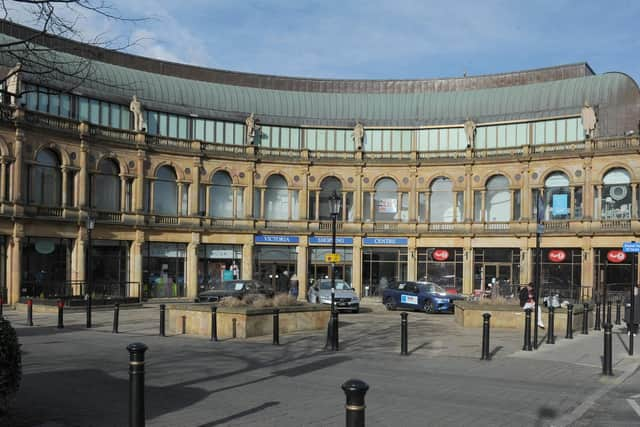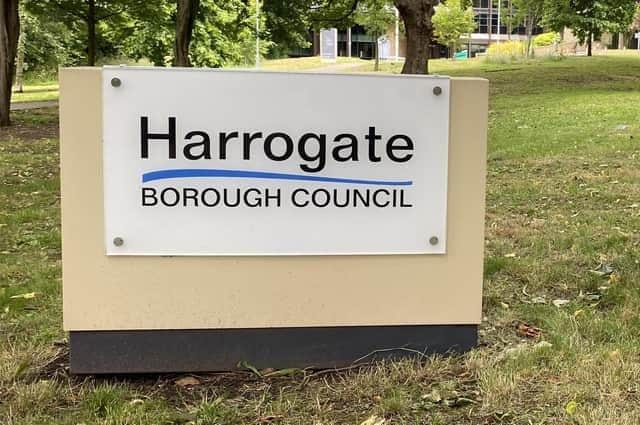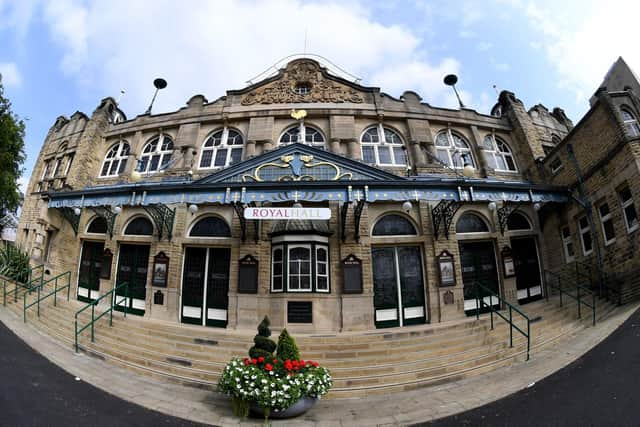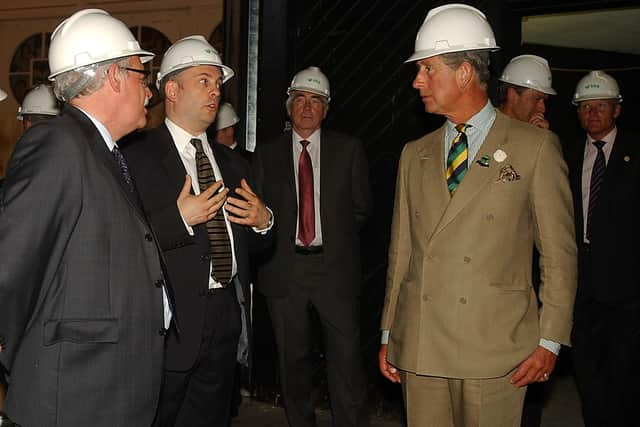Harrogate council’s biggest moments: A shopping revolution, Royal Hall rebirth and controversial new offices
and live on Freeview channel 276
From controversy over the Harrogate conference centre to the move from Crescent Gardens to the Civic Centre — the council has played a major role in the look, feel and development of the district for the last 49 years.
As well as searching the archives of the Harrogate Advertiser we spoke to some of the people who were involved at the time to give a picture of how these five events unfolded.
Advertisement
Hide AdAdvertisement
Hide Ad

1974: Dawn of a new council
Harrogate Borough Council was new and shiny once.
Its creation followed years of wrangling over boundaries. At one point, it looked like Harrogate and Knaresborough was even going to be incorporated into a Leeds council.
But the new two-tier system was launched at midnight on April 12, 1974 and it saw North Yorkshire County Council and Harrogate Borough Council share responsibilities in the newly-created Harrogate district.


Old rural councils as well as the councils for Harrogate, Ripon and Knaresborough were brought together to form Harrogate Borough Council and it put the town of Harrogate at the heart of decision-making in the district.
Advertisement
Hide AdAdvertisement
Hide AdOn April 6, 1974, the Harrogate Advertiser described “the great changeover”:
“At midnight on Sunday, local government old-style ended and the new style has given Harrogate and a huge surrounding area of 515 square miles a new district council, by which the council of the borough of Harrogate came into full operation and responsibility.”
When the council launched, it owned 7,000 council houses, almost double what it owns today, and it served a population of 135,000 residents.


Conservative councillor for Burton Leonard, Graham Bott, became the first mayor of the borough at a ceremony at the Royal Hall that month.
Advertisement
Hide AdAdvertisement
Hide AdCllr Bott described becoming mayor as one of the proudest moments of his life. He said he hoped Harrogate Borough Council would abide by the motto of the Three Musketeers — “one for all and all for one.”
Sixty councillors were elected to serve on the first council and they were paid £10 to attend meetings that lasted over 4 hours, which dropped to £5 for shorter ones.
The council’s first chief executive was Neville Knox. He said the council’s size meant it would still be in touch with residents.


Mr Knox said: “We are still small enough not to have lost contact with the rate payers. We have experienced officers in the branch who know the people of their areas.”
Advertisement
Hide AdAdvertisement
Hide AdBut even in the council’s formative days, questions were being asked about how the council in Harrogate would look upon the rest of the district.
A Harrogate Advertiser columnist from Ripon asked, “Is big brother Harrogate going to grab all the goodies for itself?”
It said: “One fear is that the natural and historic assets of Harrogate’s neighbours will be used not so much to their own advantage but primarily as additional bait to enhance the attraction of the main centre and Harrogate as a tourist, trade fair and conference centre.”
This received a firm rebuttal from Tony Bryant, the council’s director of conference and resort services, whose comments draw parallels with what is being said by officials at North Yorkshire Council 49 years later.
Advertisement
Hide AdAdvertisement
Hide AdMr Bryant said: “We shall no longer be a collection of small authorities trying with limited resources to sell itself, but a large body in which finance will be combined for the common good.”


There was much work to be done and the Harrogate Advertiser wrote in an editorial that the council “cannot afford the luxury of taking time to settle in” as there were huge traffic problems, car parks and the construction of new roads that had to be dealt with.
But a squabble over ceremonial robes dominated the council’s first meeting.
1982: the conference centre opens under a cloud
Advertisement
Hide AdAdvertisement
Hide AdThe story of Harrogate Borough Council will be forever bound to the town’s conference centre.
The venture was undoubtably the council’s boldest move but it’s fair to say that controversy has dogged what is now the Harrogate Convention Centre ever since the council decided to build it in the 1970s.
Harrogate was already known as a conference destination but the council hoped a new state-of-the-art facility in the centre of town would attract business and leisure visitors to the district for decades to come.
Harrogate Borough Council part-funded the investment through selling land it owned off Skipton Road to housebuilders. This would eventually lead to the building of much-needed new homes for Harrogate and the creation of the sprawling Jennyfields estate.
Advertisement
Hide AdAdvertisement
Hide AdHowever, in 1979 when construction on the conference centre was underway, the UK was in the grip of a deep recession and Margaret Thatcher’s newly elected Conservative government raised the interest rate to 17%, in a bid to bring down inflation that was running at 13%.
Tim Flanagan was chief reporter at the Harrogate Advertiser during the 1970s and 1980s. He remembers the conference centre was rarely off the front pages during that time.
Mr Flanagan said costs for the conference centre spiralled from an initial £8m to £34m, which shocked the Harrogate public and led to a hike in council tax.
He said: “Against the backdrop of recession, inflation and high interest rates, the council’s finances were stretched to the limit.
Advertisement
Hide AdAdvertisement
Hide Ad“This led it to it to make the decision to levy a supplementary rate to balance the books – a move that proved highly unpopular with ratepayers across the district.”
Harrogate Borough Council was bailed out by a £16m loan from the government to pay off the conference centre. It reduced what residents would have been asked to pay in council tax by 25%.
If the 40-year terms of the loan were followed, it means the council only finished paying back the government for the bailout last year.
Problems at the conference centre would mount throughout the 1980s as the hotel group originally chosen to be part of the development pulled out and it took until 1985 for what is now the Crown Plaza to be occupied.
Advertisement
Hide AdAdvertisement
Hide AdThe conference centre had become such a drain on resources that the council struggled to maintain prized assets such as the Sun Pavilion and Harrogate Theatre as they fell into disrepair.
Binmen were even asked to reduce their hours to save costs.
However, despite the controversies, what is now known as the Harrogate Convention Centre has been a cornerstone of the town’s economy for the last 40 years.
It will also always have its place in UK pop culture history after it hosted the Eurovision song contest in the venue’s first year.
The contest was eventually won by German singer Nicole and saw Harrogate showcased to hundreds of millions across the world.
Advertisement
Hide AdAdvertisement
Hide Ad1992: The future of shopping comes to Harrogate
Speak to a Harrogate resident over the age of around 40 it’s likely they will talk with fondness about the town’s former indoor market that was demolished in 1991.
For some, shopping has never quite been the same since the council approved the demolition so it could be replaced with the £50m Victoria Shopping Centre.
Advertisement
Hide AdAdvertisement
Hide AdThe old market was well-loved and included butchers, fishmongers, florists, needlecraft shops, second-hand book and record shops and much more.
But the late 20th century was the era of the shopping mall and there were hopes in Harrogate that a more modern facility would revitalise the town centre and attract major national brands. The market traders would be invited to take the space downstairs as part of the project.
Funding came from National Provident Institution and it was developed in partnership between Harrogate Borough Council and Speyhawk Retail plc.
The plans included a council-owned 800-space multi-storey car park on the other side of the train tracks with a bridge to connect shoppers.
Advertisement
Hide AdAdvertisement
Hide AdBut the scheme was developed during the recession of the early 1990s that hit the town hard.
Harrogate’s bus station had been boarded up due to financial difficulties and the letters pages of the Harrogate Advertiser was full of fears about the town becoming a wasteland of empty shops and buildings.
During construction, market traders were moved to a temporary market on Station Parade while they eagerly awaited their new home to open.
Excitement was building and in early 1992 the Harrogate Chamber of Trade and Commerce suggested good times were finally around the corner. It called on the Harrogate public to be more positive.
Advertisement
Hide AdAdvertisement
Hide AdThe Victoria Shopping Centre was designed by architects Cullearn & Phillips and was inspired by Palladio’s Basilica in Vicenza.
But its most controversial aspect were the sculptures depicting customers and staff on the balustrade around the roof line with the Harrogate Civic Society leading calls to see them removed.
However they are still there to this day after the developer insisted they were a fundamental part of the design.
In the summer of 1992, Speyhawk revealed that 40% of the units had been filled by brands including Tie Rack, Levi’s and the Body Shop.
Advertisement
Hide AdAdvertisement
Hide AdThe underground market hall was opened on October 20 by then-mayor of Harrogate Barbara Hillier, with the rest of the shopping centre opening on November 9.
There was a wave of optimism from shoppers who described the town’s new venue as the future of shopping.
There were 54 units for market traders on the ground floor and they were quickly occupied. Butcher Brian Noon told the Advertiser in 1992: “I think its brilliant! The developers have thrown a lot of money at it to make sure the building is tip-top.”
Harrogate Wools owner Bill Lee was similarly optimistic about the building’s future. He said: “It will bring people back to Harrogate because they definitely have not been coming. I haven’t heard one complaint.”
Advertisement
Hide AdAdvertisement
Hide AdThe Victoria Shopping Centre was built in the years just before internet shopping took hold, which was perhaps not to have been foreseen.
Enthusiasm slowly ebbed away during the 1990s and 2000s as the market traders on the ground floor left one-by-one.
Today, the Victoria Shopping Centre still features big high-street names like WHSmith, TK Maxx and HMV. The town’s post office also moved there in 2019.
It’s now owned but not run by Harrogate Borough Council. The Local Democracy Reporting Service revealed last year its value has fallen by more than 80% in 10 years.
Advertisement
Hide AdAdvertisement
Hide AdHarrogate Borough Council said it could receive a boost in shoppers if another controversial scheme, the Station Gateway, goes ahead.
But that will be a decision for North Yorkshire Council.
2008: A dilapitated Royal Hall brought back to former glory
The Royal Hall’s halycon days saw it host the likes of the Beatles as well as the music, arts and comedy stars of the time.
But by the turn of the twentieth century, Harrogate’s grandest council-owned building had fallen into rack and ruin. In 2002 it closed to the public after part of its famous ceiling collapsed.
Advertisement
Hide AdAdvertisement
Hide AdIt’s downfall was in part, due to the town’s conference centre being such a drain on the council’s resources, according to the book Kursal – a History of Harrogate’s Royal Hall.
It was in such a poor state of repair that the unthinkable was being broached by councillors — after almost 100 years the Royal Hall could be condemned and demolished.
Refurbishment was originally estimated to cost £8.56m with the council likely to having to stump up £2m from its own coffers. The remaining amount would come from a Heritage Lottery Fund grant.
However, there were fears the risky project could potentially bankrupt the authority.
Advertisement
Hide AdAdvertisement
Hide AdIts emotional importance to the town was not only felt by residents in the town but by performers too.
The Royal Hall Restoration Trust was formed in 2001 after then-leader of the council, Cllr Geoff Webber, suggested to the chairman of Harrogate Civic Society, Lilian Mina, that the council would welcome the support of an independent organisation whose prime role would be raising money for the refurbishment.
Then followed tea dances, school concerts, charity balls and other events, which raised £2.7m for the restoration — far more than the £1m it originally expected.
Lilian Mina died in 2008 and Geoff Webber died in 2021 but his son Matthew Webber, who is currently a Liberal Democrat Harrogate councillor, paid tribute to those who spearheaded the campaign to save the Royal Hall.
Advertisement
Hide AdAdvertisement
Hide AdIt was officially re-opened by patron of the trust Prince Charles in 2008 after six years of works.
Cllr Webber said: “I am very proud of the work done by my late father as council leader at the time in conjunction with the Lilian Mina and the Royal Hall Preservation Trust that led to the Royal Hall being returned to its continued use today.”
2017: The council says goodbye to Crescent Gardens and moves to a new home
Advertisement
Hide AdAdvertisement
Hide AdLike the conference centre throughout the 1980s, it was Harrogate Borough Council’s move away from Crescent Gardens that dominated council-business during the mid-2010s.
Crescent Gardens had been used by HBC since 1974 and before that was used by the predecessor council in Harrogate ever since it opened on Halloween 1931.
But by the 21st century, the neo-classical building was showing its age and had become expensive to maintain for the council.
In 2010, the Conservative and Liberal Democrat coalition government came to power and councils were ordered to find savings under its programme of austerity.
Advertisement
Hide AdAdvertisement
Hide AdFor the council, Crescent Gardens was an obvious place to look.
The council put forward several proposals, which included refurbishing Crescent Gardens, but it ultimately decided to build new offices on land it already owned at Knapping Mount off King’s Road.
At the time, it said the build would cost £8m although the move, as well as the selling off of other offices, would save around £1m in year due to reduced costs involved with maintaining the older buildings.
Tantalisingly for the council, there were hopes it could sell Crescent Gardens to a luxury developer. Then-council leader Don Mackenzie was quoted saying it could generate an investment of up to £30m into the district’s economy.
Advertisement
Hide AdAdvertisement
Hide AdAnother former Conservative council leader, Anthony Alton, told a meeting the move was probably the biggest decision the council has taken since 1974. He added: “We are in a continuing economic downturn which means that we have to make every penny count.”
The move to the Civic Centre was always contentious.
The Liberal Democrats argued that £2.5m should be spent on a refurbishment of Crescent Gardens and the Knapping Mount site should be sold for affordable housing.
They also criticised its circular design, saying it would increase costs.
Apart from during the covid lockdowns, council staff have been using the Civic Centre since December 2017.
Advertisement
Hide AdAdvertisement
Hide AdCrescent Gardens on the other hand is still empty, almost five years’ since Harrogate Borough Council moved out.
The council originally announced it would sell it to property developer Adam Thorpe who had plans for a £75m redevelopment including luxury apartments, an art gallery, underground car park, swimming pool and restaurant.
But two years later, Mr Thorpe’s company ATP Ltd fell into administration with debts of almost £11m, including £24,394 owed to the council.
Crescent Gardens then went back up for sale and was eventually bought for £4m by Impala Estates in 2020.
The Harrogate-based developer was granted planning permission last year for a major refurbishment of the building that will see two-storey extension, rooftop restaurant, gym and new office space.